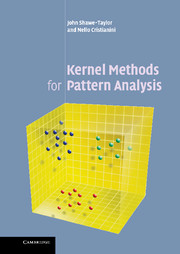Book contents
- Frontmatter
- Contents
- List of code fragments
- Preface
- Part I Basic concepts
- Part II Pattern analysis algorithms
- Part III Constructing kernels
- 9 Basic kernels and kernel types
- 10 Kernels for text
- 11 Kernels for structured data: strings, trees, etc.
- 12 Kernels from generative models
- Appendix A Proofs omitted from the main text
- Appendix B Notational conventions
- Appendix C List of pattern analysis methods
- Appendix D List of kernels
- References
- Index
10 - Kernels for text
from Part III - Constructing kernels
Published online by Cambridge University Press: 29 March 2011
- Frontmatter
- Contents
- List of code fragments
- Preface
- Part I Basic concepts
- Part II Pattern analysis algorithms
- Part III Constructing kernels
- 9 Basic kernels and kernel types
- 10 Kernels for text
- 11 Kernels for structured data: strings, trees, etc.
- 12 Kernels from generative models
- Appendix A Proofs omitted from the main text
- Appendix B Notational conventions
- Appendix C List of pattern analysis methods
- Appendix D List of kernels
- References
- Index
Summary
The last decade has seen an explosion of readily available digital text that has rendered attempts to analyse and classify by hand infeasible. As a result automatic processing of natural language text documents has become a main research interest of Artificial Intelligence (AI) and computer science in general. It is probably fair to say that after multivariate data, natural language text is the most important data format for applications. Its particular characteristics therefore deserve specific attention.
We will see how well-known techniques from Information Retrieval (IR), such as the rich class of vector space models, can be naturally reinterpreted as kernel methods. This new perspective enriches our understanding of the approach, as well as leading naturally to further extensions and improvements. The approach that this perspective suggests is based on detecting and exploiting statistical patterns of words in the documents. An important property of the vector space representation is that the primal–dual dialectic we have developed through this book has an interesting counterpart in the interplay between term-based and document-based representations.
The goal of this chapter is to introduce the Vector Space family of kernel methods highlighting their construction and the primal–dual dichotomy that they illustrate. Other kernel constructions can be applied to text, for example using probabilistic generative models and string matching, but since these kernels are not specific to natural language text, they will be discussed separately in Chapters 11 and 12.
- Type
- Chapter
- Information
- Kernel Methods for Pattern Analysis , pp. 327 - 343Publisher: Cambridge University PressPrint publication year: 2004
- 1
- Cited by

